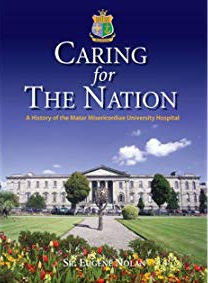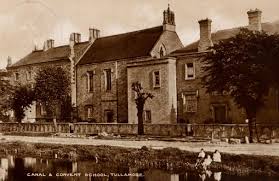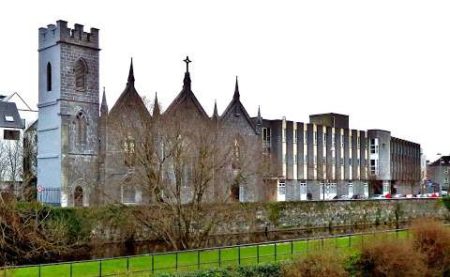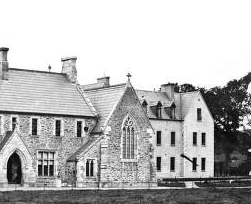For the past six months of the COVID-19 pandemic we have gone through many phases and many emotions. We have felt disbelief that this virus was in our midst, fear and terror sometimes, and sorrow and pain at the deaths and suffering. We have been thankful for the great care and goodness we receive; we are in awe at the self-giving of so many. We have learned so much; we realise that our community spirit has never gone away. We see our church offering hope and prayer in a new way, we understand that all jobs are important and necessary, that each of us has a part to play and that we are all in this together.
The history of Mercy in Ireland shows that the congregation, particularly in the 19th century, ministered and lived in the shadow of regular outbreaks of epidemics – smallpox, cholera, typhoid, scarlet fever, tuberculosis. Then, as now, these epidemics affected the disadvantaged and marginalised disproportionately. Their spread was facilitated by poverty, famine, poor living conditions and inadequate healthcare. The following extracts from annals and publications supplied by archivists from the Northern, Southern, South Central and Western Provinces illustrate how Mercy experienced these epidemics and how it drove them to improve the provision of healthcare.

Sr. Eugene Nolan’s 2013 history of the Mater Hospital Dublin ‘Caring for the Nation,’ provides ample evidence of the ravages of recurring epidemics and the efforts to cope with them. The Mater opened on 24th September 1861, Catherine McAuley’s dream, ‘a hospital of their own,’ for the care of the poor of Dublin, a city riven with poverty and disease, now beyond our comprehension. We cannot imagine the groundbreaking importance of this new hospital within walking distance of one of the largest slum tenements in Europe.
The cholera outbreak in Dublin in 1832 had claimed the lives of 5,632 people. Hospitals were a place of shame, nobody wanted to be there, or have one built in their locality. The Famine 1845 – 1849 led to abysmal tenements. Sr. Cecilia Marmion, Reverend Mother of Baggot Street, who was spearheading the building of the new hospital died herself of typhus in 1849.
The outbreak of cholera in August 1866 was the first significant challenge to the Mater Hospital. Hospitals were reluctant to admit its victims. The Mater did. A ‘cholera cart’ painted yellow, collected patients and took them to the hospitals. Patients would be left on hospital steps during the night. 143 cases died in the Mater at this time.
In 1871 the city was smitten with smallpox, spreading like wild fire, causing enormous fear. If a family member had it, anyone in that family in employment immediately lost their job. Six to eight hundred patients were treated in the Mater with a high mortality rate of patients and staff. Over 2,000 people died in the city.
In 1886 there was another outbreak of cholera and a further outbreak of smallpox in 1894. Again the city was ravaged. The city council discussed building a special fever hospital for contagious diseases; this was opposed by the public.
Wave after wave of epidemics visited the city; ‘scarlatina,’ scarlet fever, came in 1896, largely involving children. On one day there was a total of 630 ‘notified cases.’
Then the influenza pandemic or Spanish Flu of 1918 – 1920 made its appearance in the North East of the country and quickly spread. The Mater was inundated with patients. The mortality rate was so high that some died before they got a bed. The incidence of disease and death rate among Mater staff became a serious concern. The hospital mortuary filled and couldn’t be emptied, because the option for families to bring the body home was not advisable and cemeteries were in danger of being overwhelmed. At times, coffins were also in short supply and the authorities opened some of the vaults in Dublin cemeteries to store the bodies until the situation improved. In excess of 20,000 were thought to have died directly from the flu with many others dying from pneumonia or complications of the illness.
The annals and histories of other Mercy communities also chronicle the impact of recurring epidemics as illustrated by the following from convents in Tullamore, Galway and Killarney.
Extracts from Tullamore Annals 1840 and 1864
Fever still continued to rage in the town and of course the poor were the victims. As the Sisters were increasing in their visits to the poor sufferers, they naturally caught the infection. Sister Martha was the first who fell ill and two days afterwards Mother M. Teresa and Elizabeth the Postulant…In the course of time all, thank God, recovered. Owing to the prevalence of fever in the locality and the community usually suffering from it the Bishop formally forbade the Sisters to attend infectious cases and although often called upon to revoke the prohibition he could not be prevailed on to do so, especially after the establishment of the fever hospital. He often and often repeated that the Sisters attend the sick for a two-fold spiritual object, instruction and consolation. Now he looked on this as out of the question in fever cases – not much good can be done for the poor suffering in this way, but much, very much harm to the Sister visitor and her community every member of which is so closely bound together by sympathy of avocation, constitution and education. He thought if the Sisters attend infectious cases they must lay aside other sick patients with whom they could do good and especially would they be obliged after to relinquish care of the schools and such other duties to which they were bound, not to speak of those many social ties of community life which are so often snapped asunder by illness.
 St. Joseph’s Convent, Tullamore, Co Offaly
St. Joseph’s Convent, Tullamore, Co Offaly
1864 A very malignant fever visited the community, and several Sisters fell ill of it. The first was a novice, Sr. M. Teresa, then another novice, Sr. M. Columba, who had just passed the Chapter for Holy Profession, then the lay postulant, and just as these were recovering, the Head Infirmarian, Mother M. Vincent and her assistant, Sr. M. Augustine were attacked by the same fever, but in a milder form. Two servants also caught it, and were sent to the hospital. The schools were obliged to be closed for about a month, and two nurses hired to attend to the sick Sisters. All got fairly through the sickness….We felt truly grateful to Almighty God for sparing the lives of all…Great caution was observed during the convalescence of the Sisters, they were kept apart from the community for a fortnight or so after leaving the infirmary, and were allowed to spend all their time in the garden. On the feast of St Anne, 26th July, all met again in the refectory, and joined in the duties as before their illness. Great was the joy on both sides and loud was our gratitude to God. May His name for ever be praised!
St. Vincent’s Convent, Galway
 St. Vincent’s Convent of Mercy, Galway
St. Vincent’s Convent of Mercy, Galway
1849 saw an outbreak of cholera in Galway. The patients of the Fever Hospital were transferred to cabins and sheds in the Workhouse grounds where temporary accommodation was provided to protect them from the epidemic. The Mercy Sisters nursed the cholera cases day and night in the Fever Hospital and two died, Sr. Joseph Joyce and Sr. Agnes Smith. The Sisters had been visiting the workhouse since 1842 and in 1864 were invited by the Poor Law Guardians to nurse in the workhouse infirmary. Three Sisters, Regis Macklin, Aloysius Hogan, and Ignatius Ryan took up duty on 20th February 1865 at a salary of £25 per year and a pint of milk daily. A Sister also took up duty in the kitchen. With the approval of the medical officer, they helped to introduce many needed reforms and improved the primitive conditions in the infirmary – bedsteads and hair mattresses replaced straw palliases, the decoration of the wards was improved and food preparation was reorganized. Hitherto the food for the day was issued each morning and much of it was spoiled and inedible by evening; it was thenceforth prepared and distributed for each meal. Fanny Taylor (Mother Magdalen Taylor, foundress of the Poor Servants of the Mother of God) wrote of her visit to the workhouse infirmary in her book, Irish Homes and Hearts, published 1867 “Many of the rooms are not at all suited for sick wards. Notwithstanding all the difficulties, the Sisters have done wonders. The infirmary is perfectly clean. Everything is in order, an air of comfort pervades the place. We happened to see the dinners served; the quality of food and the nicety with which it was sent up, formed a great contrast to the wretched food and dirty plates used in workhouses belonging to rich English unions”
Holy Cross Convent, Killarney
“What’s in a name?” Juliet asked Romeo.
 Holy Cross Convent, Killarney, Co Kerry
Holy Cross Convent, Killarney, Co Kerry
For the Sisters of Mercy in their new convent in Killarney in 1857 the same question could be asked. The first Convent of Mercy in Killarney in 1844 was called St. Bridget’s. Their new convent was called Holy Cross. Why the change of name? The Famine was the reason…it had changed everything for the fledgling community.
“Well it was for the sick and the dying that the Sisters were there to visit them in their homes or nurse them with skill and care in the hospital-wards set up in the newly finished Cathedral. That the Famine left so few marks of its grisly trail in Killarney and district is due in no small measure to the devoted care and skill of this noble band of Mercy Nuns who, day after day, visited the fever-stricken in the crowded lanes. During this dreadful time the number of sick arriving in the town was so great that new arrivals had to be placed on straw along Henn Street until space was made available in the auxiliary hospital in Brewery Lane, the temporary wards in the Cathedral being full to over-flowing. Then it was that the nuns showed what courage means. When fever raged and people were afraid to enter the houses of the sick and left food or milk on the window-sill outside the Nuns entered fearlessly, attended the sick and dying or coffined the dead. One of them Sr. Stanislaus was looked on as an angel of Mercy so assiduous was she in her ministration to the sick and suffering. The price which the devoted Sisters paid subsequently was high. In the thirteen years following the Famine, thirteen members of the community went to an early grave in the little cemetery at the rear of St. Bridget’s. Reverently their remains were removed to the cemetery of Holy Cross when the new Convent of Mercy was opened in 1857.” Extract from Centenary Souvenir 1844 – 1944 by J.P. O’Reilly.
We are living in difficult times, but as history shows, epidemics have always been with us and can be treated successfully. Medical advances and improvements in housing, public health and sanitation have largely curtailed the diseases so prevalent in the 19th century. We hope that similar medical breakthroughs and a re-evaluation of the way we treat the natural world may also curtail this corona virus and potential successors.
At this time may we all be blessed and safe and kind.
Marianne Cosgrave, Mary Coyle, Dora Lynch, Joan Dunne, Mae Moore, Teresa Delaney
Archives


